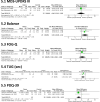The efficacy of dance for improving motor impairments, non-motor symptoms, and quality of life in Parkinson's disease: A systematic review and meta-analysis
- PMID: 32756578
- PMCID: PMC7406058
- DOI: 10.1371/journal.pone.0236820
The efficacy of dance for improving motor impairments, non-motor symptoms, and quality of life in Parkinson's disease: A systematic review and meta-analysis
Abstract
Dance may help individuals living with Parkinson's disease (PD) improve motor and non-motor symptoms that impact quality of life (QOL). The primary aim of this systematic review of randomized controlled trials (RCTs) was to evaluate the efficacy of dance in improving motor and non-motor symptoms of PD and QOL. The secondary aims of this review were to evaluate the methodological quality of included studies by assessing risk of bias across nine categories and to inform the direction of future research. Peer-reviewed RCTs that included people living with PD at all disease stages and ages and measured the effects of a dance intervention longer than one day were included. Sixteen RCTs involving 636 participants with mild to moderate PD were eligible for inclusion in the qualitative synthesis and nine in the meta-analysis. Overall, the reviewed evidence demonstrated that dance can improve motor impairments, specifically balance and motor symptom severity in individuals with mild to moderate PD, and that more research is needed to determine its effects on non-motor symptoms and QOL. RCTs that use a mixed-methods approach and include larger sample sizes will be beneficial in fully characterizing effects and in determining which program elements are most important in bringing about positive, clinically meaningful changes in people with PD.
Conflict of interest statement
The authors have declared that no competing interests exist.
Figures





References
Publication types
MeSH terms
LinkOut - more resources
Full Text Sources
Medical
Miscellaneous

